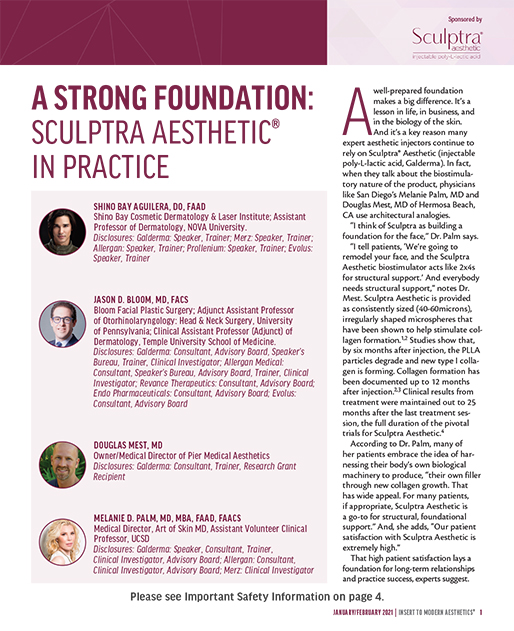A well-prepared foundation makes a big difference. It’s a lesson in life, in business, and in the biology of the skin. And it’s a key reason many expert aesthetic injectors continue to rely on Sculptra® Aesthetic (injectable poly-L-lactic acid, Galderma). In fact, when they talk about the biostimulatory nature of the product, physicians like San Diego’s Melanie Palm, MD and Douglas Mest, MD of Hermosa Beach, CA use architectural analogies.
“I think of Sculptra as building a foundation for the face,” Dr. Palm says.
“I tell patients, ‘We’re going to remodel your face, and the Sculptra Aesthetic biostimulator acts like 2x4s for structural support.’ And everybody needs structural support,” notes Dr. Mest. Sculptra Aesthetic is provided as consistently sized (40-60microns), irregularly shaped microspheres that have been shown to help stimulate collagen formation.1,2 Studies show that, by six months after injection, the PLLA particles degrade and new type I collagen is forming. Collagen formation has been documented up to 12 months after injection.2,3 Clinical results from treatment were maintained out to 25 months after the last treatment session, the full duration of the pivotal trials for Sculptra Aesthetic.4
According to Dr. Palm, many of her patients embrace the idea of harnessing their body’s own biological machinery to produce, “their own filler through new collagen growth. That has wide appeal. For many patients, if appropriate, Sculptra Aesthetic is a go-to for structural, foundational support.” And, she adds, “Our patient satisfaction with Sculptra Aesthetic is extremely high.”
That high patient satisfaction lays a foundation for long-term relationships and practice success, experts suggest.
Building Buzz
Miami dermatologist Shino Bay Aguilera, DO says that his use of Sculptra Aesthetic has built up demand for his services—from first-timers to long-term patients. “I have patients who started with me about 12, 13 years ago, using Sculptra Aesthetic. Other people wonder why they look the way they look, why the years are passing, yet they still maintain that youthful look,” he shares. “When they learn that the results are from Sculptra Aesthetic, everyone wants it. I get DMs. I get emails. Everybody wants to come see me.”
Dr. Aguilera credits Sculptra Aesthetic for his booming word-of-mouth patient base. “By word of mouth, I get so many patients,” he says.
At his suburban Philadelphia practice, facial plastic surgeon Jason Bloom, MD similarly finds that Sculptra Aesthetic has broad patient appeal. “I use it across the board for a number of different issues. In a younger patient, I will use it to enhance what they currently have,” he says. “In a patient who’s in middle age who has begun to experience some volume loss, I’ll give them a standard two vials, two treatments in order to replenish some of their volume in their their pre-auricular area and throughout their lower buccal hollows or submalar areas, which is a very hard area to treat with HA filler.”
Results with Sculptra Aesthetic speak for themselves, according to physicians. However, the product’s action—stimulating the body’s natural collagen production1—is also a selling point. “Many patients, especially younger ones, don’t want some gel in the face that’s going to be too obvious. They just want to stimulate their own collagen and look better,” Dr. Bloom observes.
“My busy professionals, patients in the public eye, and others concerned about filler placement as, ‘putting something foreign in their skin,’ appreciate the biostimulatory effect,” Dr. Palm offers.
The delayed onset of action, “can actually be an advantage,” Dr. Palm adds. "My male patients appreciate gradual but meaningful results over time. There is still, unfortunately, somewhat of a stigma associated with them getting a cosmetic procedure.”
The onset of action for Sculptra Aesthetic requires that injectors partner with patients to educate them and set expectations, experts agree. Dr. Bloom discusses the mechanism of action of poly-L-lactic acid at the initial visit and tells patients to expect to wait a few weeks after treatment to see results.
In studies of Sculptra Aesthetic, 66 percent of new type 1 collagen growth occurred in the first three months after treatment.3 With this in mind, Dr. Bloom schedules all Sculptra Aesthetic patients for a six-week follow-up. “Because right at that six week time period, the collagen is starting to stimulate and they begin to see something,” he says. “I tell them that two to three months after their final treatment is when it’s looking amazing.”
Dr. Mest advocates relatively early initiation of Sculptra Aesthetic. “I think the homerun patient for Sculptra Aesthetic is 35 to 50 years old,” he suggests.
Building Relationships
In addition to attracting patients to the practice, experts say that offering Sculptra Aesthetic sets the stage for an active long-term patient relationship. Returning to his remodeling analogy in which Sculptra Aesthetic provides structural support, Dr. Mest says, “I tell patients we might still need to put in a new door or window. And that’s where I look to a filler.”
“The degree of collagen stimulation you get from doing a series of Sculptra Aesthetic injections—over the long term, particularly if somebody has a larger surface area to rejuvenate—can become far more cost effective than initially trying to correct some of that with hyaluronic acid or another product,” Dr. Palm says. “I think of this as foundation, for getting patients to a degree of correction. Then I talk to patients about a maintenance plan.”
Most of Dr. Palm’s patients return at least one to two times per year for assessment and to determine if there is anything else necessary to maintain results or to address new areas of cosmetic concern. “I use hyaluronic acid fillers as complements and accentuation points or in areas where Sculptra Aesthetic is not appropriate.”
Dr. Palm emphasizes that she wants her patients to avoid “ebbs and flows.” Although results of Sculptra Aesthetic injection last up to 25 months,*,4 “We continue to age a little bit,” she says. “I want to keep them at that upper plateau once we’ve achieved correction.”
“My patients are in a program that they know that they need to come back once a year for their touch-up to make sure that they keep the result that they got,” says Dr. Aguilera. “I do use other fillers in practice, too. Mostly I use them to enhance, to contour, but not as my go-to product to replace age-related volume loss.”
Dr. Mest reinforces that most patients treated with Sculptra Aesthetic are also candidates for neuromodulators and will remain on a consistent schedule to receive those injections. Data from Galderma’s ASPIRE Rewards program back up the observation, showing that patients are ofen treated with two or more other products from the family of Galderma aesthetic injectables.5
ASPIRE Galderma Rewards is a program designed to strengthen the relationship a physician builds with his/her aesthetics patients. (Learn more at www.aspirehcp.com.) Its counterpart, ASPIRE Galderma Rewards for consumers, is designed to help consumers feel supported—and rewarded—at every step of their aesthetic journey. (Learn more at www.aspirerewards.com)
Practice Builder
It’s clear that today’s aesthetic patients have a range of cosmetic concerns, and that these concerns vary from patient to patient. That’s why Sculptra Aesthetic has emerged as a complimentary aesthetic solution for a patient-focused practice.
While it’s beneficial to market specific treatments and procedures that a practice offers, Dr. Bloom says the over-arching goal of his patient communication is to build trust and establish his expertise. “Patients mainly ask for my advice as to what I would recommend, rather than telling me about a product that they think would work for them,” he says. When he believes Sculptra Aesthetic is the best choice, he educates on its benefits, sets expectations, and provides treatment.
In the aesthetic space, consideration of return on investment is important both for the patient and the practice. Sculptra Aesthetic stands out as a winner in both regards. “In terms of ROI, because it is a product that requires the injector to have understanding of anatomy and facial aging, there is a bit of a price premium for the treatment. It is one of the higher ROI products that I perform,” Dr. Palm shares. “In terms of benefit for the patients, they are very pleased and the vast majority of them continue to use it as a part of their maintenance, cosmetic treatment plan.”
“It’s actually one of the highest return on investments for the patients,” Dr. Mest asserts, noting that it would be cost-prohibitive to use HA fillers to achieve the degree of volume replacement he gets from Sculptra Aesthetic. In addition to the high satisfaction rates that bring patients back, the fact that many patients continue to receive treatment with fillers and neurotoxins means that practices offering Sculptra Aesthetic will have multiple touch-points with patients. “It’s a fallacy that you’re losing these patients due to the long duration of effect,” he says. “Plus, they’re telling their friends, so you’re getting referrals in. The ROI is quite significant to the practice, as well.”
“I built my practice with Sculptra Aesthetic. That’s the way my practice became successful,” Dr. Aguilera adds. “That’s how my name became successful.”
* The clinical study for Sculptra Aesthetic followed patients for 25 months.
1. Vleggaar D, Fitzgerald R, Lorenc ZP. Composition and mechanism of action of poly-L-lactic acid in soft tissue augmentation. J Drugs Dermatol. 2014 Apr;13(4 Suppl):s29-31.
2. Stein P, Vitavska O, Kind P, Hoppe W, Wieczorek H, Schürer NY. The biological basis for poly-L-lactic acid-induced augmentation. J Dermatol Sci. 2015 Apr;78(1):26-33.
3. Goldberg D, Guana A, Volk A, Daro-Kaftan E. Single-arm study for the characterization of human tissue response to injectable poly-L-lactic acid. Dermatol Surg. 2013 Jun;39(6):915-22.
4. Brown SA, Rohrich RJ, Baumann L, et al. Subject global evaluation and subject satisfaction using injectable poly-L-lactic acid versus human collagen for the correction of nasolabial fold wrinkles. Plast Reconstr Surg. 2011;127(4):1684–1692.
5. ASPIRE data, Q3 2020




